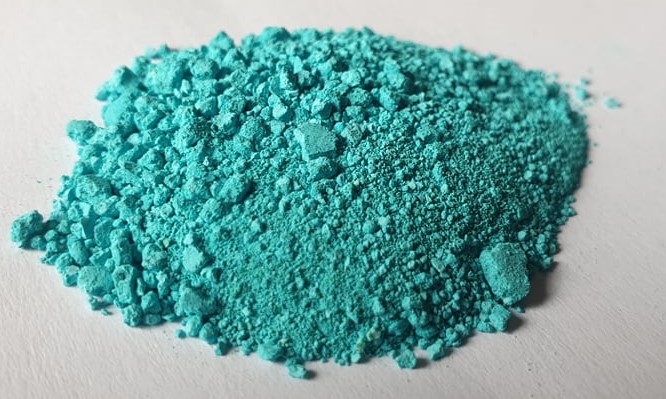A preprint on BioRxiv tells interesting things about Cu II-ATSM.
The copper compound Cu II-ATSM is in phase 2/3 for the treatment of ALS. It reproducibly improves neurodegeneration in SOD1 mouse models of ALS mutants.
 Copper(II) hydroxide, source: Vano3333 via Wikipedia
Copper(II) hydroxide, source: Vano3333 via Wikipedia
Cu II (atsm) or Copper-64 (64Cu) is an oxidized isotope of copper, with applications for molecular radiotherapy and positron emission tomography. It has a half life of 12 hours and decays in nickel 64 and zinc 64. There are many kind of copper compounds, the one pictured above is a copper(II) hydroxide.
It is not so surprising that copper may be useful for patients with SOD1 ALS, as copper is found in many superoxide dismutases (SOD), proteins that catalyze the decomposition of superoxides by converting it to oxygen and hydrogen peroxide. Indeed SOD1 is pivotal in mitigating reactive oxygen species (ROS) release during oxidative stress.
However, SOD1 mutations cause only 2% of ALS cases, most of the cases being of unknown etiology. And recent studies on Cu II (atsm) have not been very clear as to why Cu II (atsm) should be useful for sporadic cases.
Recent studies about Cu II in ALS have been mired in controversies regarding conflicts of interest or simply the use of questionable methodologies such as using BMAA poisoned mice as ALS models.
The therapeutic relevance of Cu II (atsm) for sporadic ALS is therefore unclear. This article describes an attempt to find out why it is useful in sporadic cases.
Because of its role in facilitating iron uptake, copper deficiency can produce anemia-like symptoms, neutropenia.
The authors analyzed post-mortem spinal cord tissue from sporadic cases of ALS for the anatomical and biochemical distribution of copper, the expression of genes involved in copper manipulation, and the activities of cuproenzymes.
They discovered that the natural distribution of copper is disrupted in sporadic ALS.
The tissue affected by ALS has a molecular signature consistent with an insatiable need for copper and cupro enzyme activity is affected. Copper proteins have diverse roles in biological electron transport and oxygen transportation, processes that exploit the easy interconversion of Cu(I) and Cu(II). Copper is essential in the aerobic respiration of all eukaryotes.
Copper levels are decreased in the ventral gray matter where the motor neuron bodies reside, the main anatomical site of neuronal loss in ALS.
The factors that lead to the localized accumulation observed in ALS are not yet confirmed. However, a redox imbalance involving a hyper-reducing state is involved. In short, the cellular retention of copper from copperII compounds such as CuII (atsm) is dictated, in part, by an intra-cellular reduction of copper followed by its dissociation from the ligand.
The insatiable requirement for copper which is evident in these mice is a biochemical target for Cu II (atsm). The evidence provided here for the disturbed bioavailability of copper in human cases of sporadic ALS indicates that a therapeutic mechanism for Cu II (atsm) involving the bioavailability of copper is relevant for sporadic cases of ALS, not just those involving SOD1 mutant.
Indeed more work is needed to understand why there is an intracellular deficiency in copper.
Another question is, if there is an intracellular reduction of copper, why using something as unstable as Cu II ATSM, when there are so many copper II compounds? Some that are known to be innocuous?

